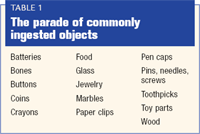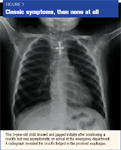Ingested and aspirated foreign bodies: Making sure that what went in comes out
The event may or may not be witnessed; the child may or may not have classic symptoms. A high index of suspicion and knowledge of the many possible presentations are your best insurance against the hazards of a missed or delayed diagnosis.
DR. ARNOLD is assistant professor of pediatrics and director of medical student and resident education for the section of emergencymedicine, Yale University School of Medicine, New Haven, Conn. She has nothing to disclose in regard to affiliations with, or financialinterests in, any organization that may have an interest in any part of this article.
Children often ingest or aspirate a foreign body, with variable outcomes. Missed or late diagnosis may lead to serious morbidity or death. The literature records many examples of bad outcomes, and subsequent legal action, resulting from delays in diagnosis.1 Aspirated foreign bodies present special risks and diagnostic challenges; delayed diagnosis is much more common for aspirated foreign bodies than foreign bodies lodged in the gastrointestinal tract.2 Recognizing the many presentations of foreign bodies and the best strategies for diagnosis and management is key to avoiding an unfavorable outcome.
Who is at risk?
An estimated 600 children die each year from complications related to a foreign body lodged in the esophagus or airway. Asphyxiation from a foreign body causes 7% of deaths among children younger than 4 years; most of these deaths occur outside the hospital.2 Most children with suspected ingestion or aspiration of a foreign body are brought to the emergency department initially, rather than to their primary care physician.2 Primary care physicians must, nevertheless, remain alert to the possibility of ingestion or aspiration, especially because they are more likely to see patients with an atypical presentation or children who have symptoms but no history of a witnessed ingestion or aspiration.

Food particles-such as peanuts, seeds, and nuts-are the foreign bodies most often found in the airway.6-8 Toy parts are the next most common aspirated objects.
Most ingestions and aspirations of a foreign body occur in developmentally normal children in their own home, under their parents' care.9 Often, the ingestion or aspiration is witnessed. When it is not and the patient is initially asymptomatic, the diagnosis is much more challenging.
Ingestion: The clinical picture

Compression of the trachea by a large foreign body in the esophagus may cause symptoms of respiratory distress. Dysphagia and drooling are more common when a foreign body lodges in the upper or mid-esophagus than when it is in the distal esophagus or stomach.10
Food impactions may produce the "café syndrome," in which the symptoms of obstruction develop while eating-generally meats that are poorly chewed. Notably, 40% to 70% of patients with a confirmed foreign body in the esophagus are asymptomatic.10-12 Most children also have a completely normal physical exam, further complicating diagnosis.